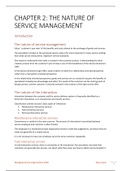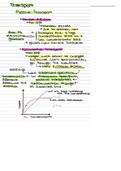SERVICE MANAGEMENT
Introduction
The nature of service management
Value: ‘customer’s eye view’ of the benefits and costs related to the exchange of goods and services.
The perception of value or the perceived service value is far more important in many service settings
than what can be measured by ‘objective’ service standards.
One needs to understand how value is created in the customer process. Understanding the value-
creation process from the customer’s pint of view is one of the foundations of the Service-Dominant
Logic.
In the Service-Dominant Logic (SDL), value creation is linked to a relationship-oriented perspective
rather than a transaction-oriented perspective.
In the relationship-oriented perspective, goods and services are co-created to acquire the benefits of
specialized competences (knowledge and skills). The needs of the customer are the starting point of
doing business, and the customer is actively involved in the creation of the right service offer.
The nature of the interaction
Interaction between the customer and the service delivery system is frequently identified as a
dimension that allows us to characterize and classify services.
Classification scheme around 3 basic types of interaction:
• Maintenance-interactive services
• Task-interactive services
• Personal-interactive services
Maintenance-interactive services
Convenience or comfort is the main concern. The amount of information transmitted between
service employee and customer is often limited.
The employee in a maintenance-type organization tends to make few judgements, and those that are
made are generally of a simple nature.
It is not necessary to have one employee serve the same customer repeatedly.
Task-interactive service
In task-interactive services, there is uncertainty in the transaction. By uncertainty, we mean that
customers are generally less precise, not about what they need, but how to obtain and accomplish it.
Managing Service Organisations 2020 Tessa Casier
1
,The information provided by the customer is not critical, a fact that reflects the client’s relatively low
level of awareness of the problem at hand. The duration of the relationship is generally relatively
long, because the flow of information is extensive.
The client is perceived as being in a dependent position. This power disparity exists because the
service employee controls more information relative to the client. The relationship is intense, and
there is usually little substitutability of service employees in the interaction.
Personal-interactive services
In personal-interactive services, there is not only uncertainty but also ambiguity.
Ambiguity: one is not only looking for answers but that even the relevant questions seem unclear.
The employees in these situations provide a personal service to clients/customers.
The skills of the service provider are crucial, personal and social skills and competencies are equally
crucial in personal-interactive services.
The professional service provider tends to dominate during the interaction. The client/customer is in
a subordinate role, and the interaction is usually a personal one. The information provided by the
client is often of a confidential nature.
The personal-interactive service firm is the most dynamic of the service organizations – dynamic in
the sense that each task – and even each episode – requires novel solutions, with the decisions of the
employees tending to be complete and judgmental.
The nature of the interaction and service management
Different types of service mighty imply different forms of management → Service triangle
Managing Service Organisations 2020 Tessa Casier
2
,A service organization is conceptualized as consisting of 3 components:
• Organizational component
o everything that belongs to the organisation itself and is clearly identified with it
• Human capital
o people come to work bringing with them technical skills, a behavioural
repertoire, as well as personal characteristics
• Behavioural repertoire
o well-trained competencies: the qualities of daily routines as communication
skills, politeness and attractiveness
By mapping the different types of interaction on the service triangle, we better understand how the
nature of the interaction can have an impact on different aspects of service management:
• The competence of the service employees
• The nature of interaction between service provider and customer
• The different types of interaction lead to different types of service processes
• In task- and personal interactive services, a relationship-oriented perspective on the
interaction is more important than in maintenance-interactive services
• The role of the customer is very different in maintenance-interactive services as compared
with task-interactive and personal-interactive services
The interaction between employees and customers in the
service chain
In practice, it is difficult in a service operation to distinguish clearly between the service, the process
of providing the service, and the system and procedures that deliver it.
Simultaneity as an inherent characteristic of service means that service organizations have a
permeable boundary between themselves and their customers.
The permeable boundary between employees and customers
The way employees feel and act has an impact on the quality of the service delivered: satisfied
people deliver good-quality service and thus value.
‘Satisfaction mirror’: the relationship between employee and customer satisfaction
Employees feeling enthusiastic about their job not only communicate this feeling both verbally or
non-verbally but are also eager to work hard towards satisfying their customers.
Employee loyalty is crucial; employees who stay on the job long enough not only develop their skills
to a high level but also start to know customers and their specific interests and needs → more value
is created → customer satisfaction increases
Much of what happens inside a service organization cannot be hidden from the customer with whom
the organization’s employees interact.
Employee and customer satisfaction leading to profitability
Service profit chain: service capability influences employee satisfaction. Employee satisfaction in turn
will lead to employee loyalty and will affect the service employees’ efforts to achieve productivity
and quality goals. This, in turn, will affect the value created for, and perceived by, the customer.
Managing Service Organisations 2020 Tessa Casier
3
, Value creation will lead to satisfied customers and eventually loyal customers, and this loyalty will in
turn contribute to profitability.
Cycle of failure: starts when the organization is looking for cost reductions in the short run. In an
attempt to reduce costs in the short run, companies start to look for people willing to work for wages
marginally above statutory minimum levels. Jobs are reduced to a series of simple and bring tasks
that require almost no training. Involve people in the company itself costs time and effort as well. In
the short run, employee costs might be minimized, but in the long run the effects are disastrous.
Conclusion
Understanding the value as perceived and determined by the customer and/or consumer is at the
heart of service.
The concept of ‘value’ is at the centre of the service profit chain, showing that a large part of this
value is created in the interaction between the service provider and the customer.
Managing Service Organisations 2020 Tessa Casier
4












